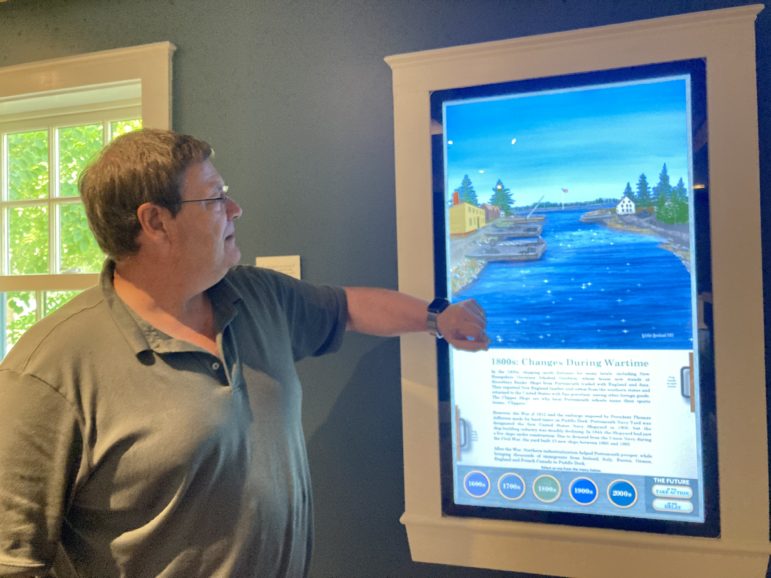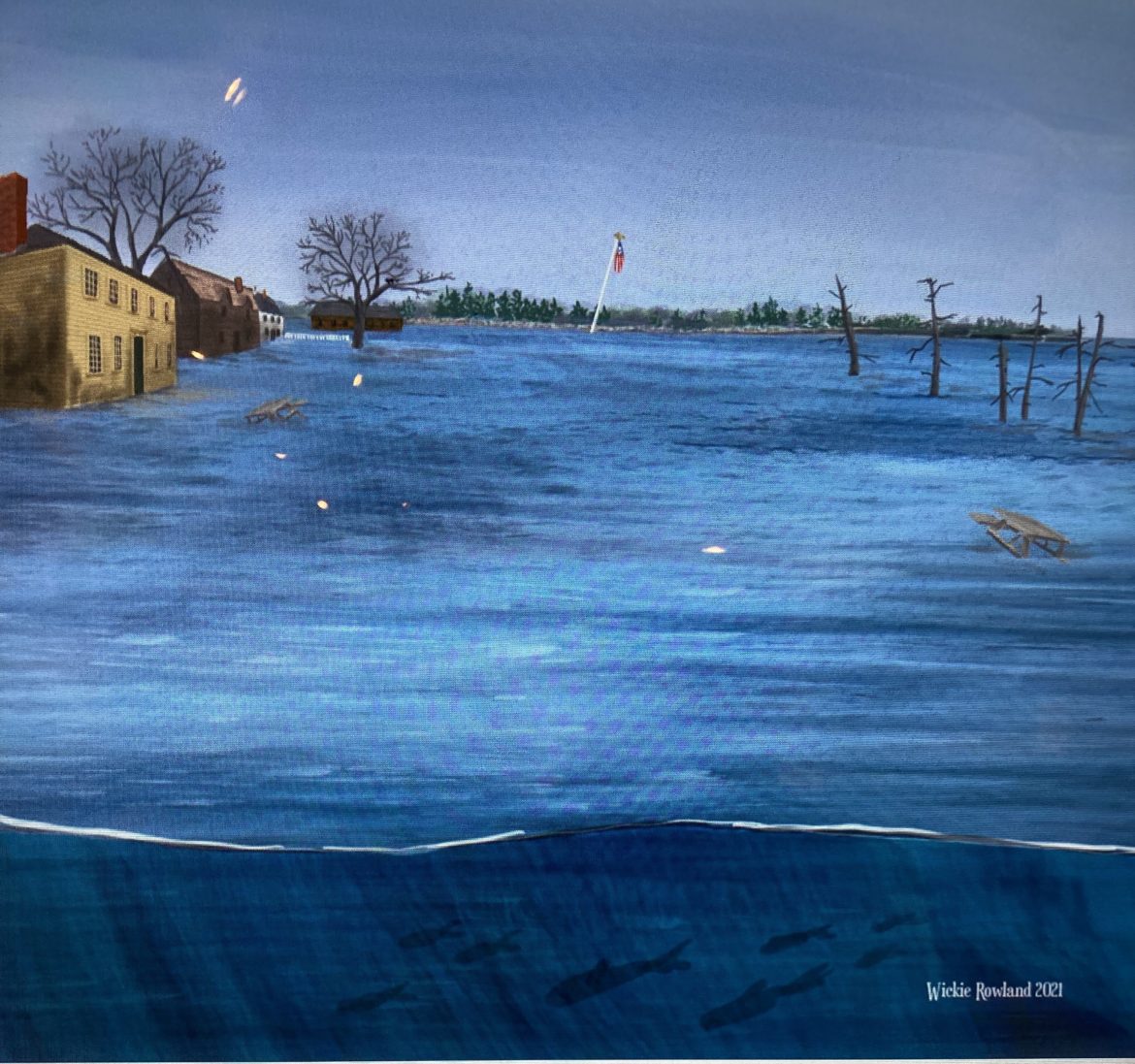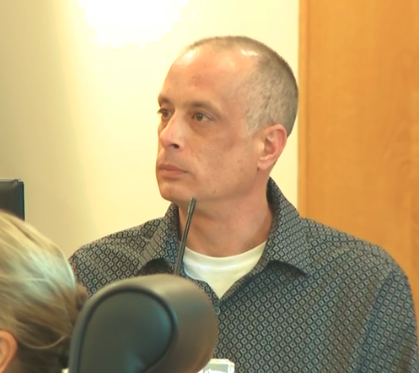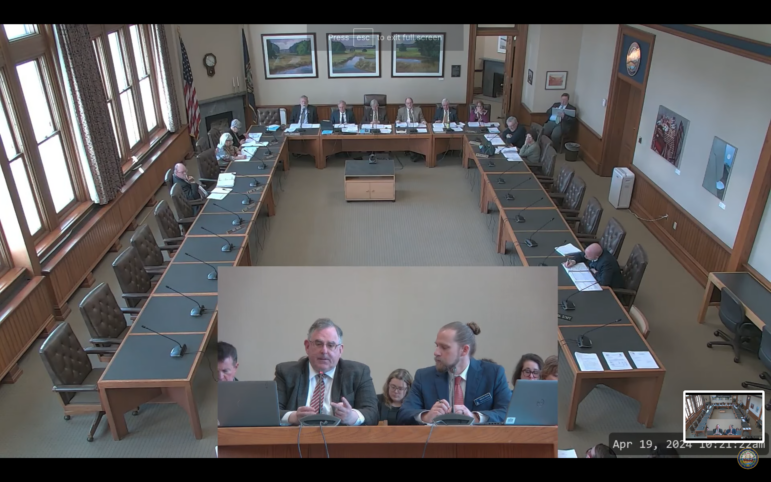
By TERRY FARISH, InDepthNH.org
In a new exhibit, Strawbery Banke is documenting sea level rise here in New Hampshire. They’re doing it at Puddle Dock which is the lowest land in the City of Portsmouth because it was built on fill.
Puddle Dock used to be a tidal inlet that flowed from the Piscataqua River. In the 1800s, wharves were built on its edges. The water continued through the middle of what’s now Strawbery Banke’s wide lawn, flowed to Pleasant Street and at high tide, sometimes, it flowed to South Mill Pond. But it was filled in by around 1900 to create more land.
There was a ten-year old boy who volunteered at the museum, way back, and stayed until he finished high school. Then he left to get a university degree in history, but returned to work in the museum. Rodney Rowland took on many jobs there until he was promoted to Director of Facilities and Environmental Sustainability. In that job he was aware of water damage to many of the houses’ chimneys and foundations. In 2016 he attended a conference called “Keeping History Above Water.”
He met staff from many museums who were facing the same damage to their buildings, and there he put parts of the puzzle together. He had thought the damage was due to water from above; then he and so many others realized the ground water was rising.
The ground water at Puddle Dock was being infiltrated by the rising sea.
Strawbery Banke opened the exhibit this summer calling it, “Water Has a Memory.” The staff’s goal is to share knowledge they’ve gained about sea level rise through collaboration with the City of Portsmouth and many non-profit, academic, and governmental organizations.
Rowland spearheaded the “Water Has a Memory” exhibit. The name is from an old saying about water, he said. Water remembers where it’s been, and it will return, like the water coming back to Puddle Dock.
The exhibit allows people to watch the sea rise in a time lapse video. Viewers can actually watch a basement fill with water as high tide comes in, and empty with the outgoing tide.
Rowland explained further about the dimensions in play. “Basements are 6 feet below grade. At king tide, 8 inches of water fill the basement. A typical high tide is 8.8 feet. But when you have an astronomically high tide impacted by the moon it goes up to about 10 1/2 feet. And that’s the breaking point for a number of our basements.
Water can go up to 26 inches, that’s during a king tide with a storm surge. That’s when we see ground water intrusion.” Rowland lists the impacts he has seen: Mildew and mold. Mortar that holds the chimney and the foundations crumbles. Basements freeze. Pipes burst. At the Shapley-Drisco House the basement is unusable and they put the furnace in the attic. “The ebb and flow of the tide finds its way into our basements but also prevents water from the sky from sinking in because there’s nowhere for it to go. We’ve become this big bowl that fills up with water.”
The museum, as a partner with the City of Portsmouth, is a case study in identifying and mitigating the impact of sea level rise on the waterfront and on ground water. At Puddle Dock they are testing models of mitigation strategies; the exhibit shows some of the strategies including rain gardens, sunken gardens of soil and plants to absorb and treat storm water. The exhibit panel ends with “But water has a memory and the sea will rise.”
“For Portsmouth it’s easier in some ways,” Rowland said. “We have a seawall that protects some of the city. The water is tidal so half the day, it’s gone.”
But that won’t be for long. The UN Intergovernmental Panel on Climate Change Regional Report stated, “It is virtually certain that global mean sea level will continue to rise over the 21st century in response to continued warming of the climate system, and this rise will continue to rise for centuries to millennia due to continuing deep ocean heat uptake and mass loss from ice sheets.”
On the Strawbery Banke side of Marcy Street, across from the Liberty Pole, is a Rockingham County Planning Commission sign indicating the likely level of sea rise which predicts a rise of 6.6 feet above mean high water by 2100.
Rowland is clearly worried about the white house, the Shapley-Drisco House. He calls it the poster child house. That’s the house built in 1795 and now has at least monthly flooding. It’s 450 feet away from the water. But the house is doing what Strawbery Banke’s mission is – to show change over time, as does a stunning animated display in the exhibit. The display features illustrations created by Rowland’s wife, artist and landscape designer Wickie Rowland. She depicts Puddle Dock over five centuries beginning with the 1600s when Abenaki and other Native peoples fished in the river. The last illustration shows Puddle Dock underwater with the caption, “If We Delay…”
Rowland said, “We’re going to lose some history.”
It’s clear that his work and the work of the city is mitigation in the face of climate change, though Rowland is passionate about measures still available to Seacoast communities.
Former NH state legislator Rebecca Emerson was a Pelican, one of the college-aged summer employees on Star Island, in the 1990s. She remembers a well on the island where “we’d sometimes get water but you had to be very careful not to pump too much or too deep because then it would come up salt.” She says that the Star Island leadership is forward thinking; the island has a sustainability program, Green Gosport Initiative, with the goal of reducing reliance on fossil fuels
Half of the exhibit at Strawbery Banke is about how people can conserve water, avoid contamination of storm drains, and protect coastal wetlands. The salt marshes on the coast form a buffer between the sea and the land. Rowland said, “The storm drains go right into the river. On an incoming tide it flows into Great Bay Salt Marsh, this beautiful estuary. All along the shore of the Piscataqua are these incredible salt marshes, but storm wash can destroy it. We need the salt marsh as a protector of the shoreline.”
About the exhibit, Larry Yerdon, President and CEO of Strawbery Banke said, “The important thing is getting the information out. Our goal to tell the story, spread the word.”





